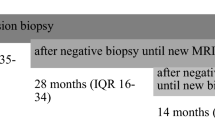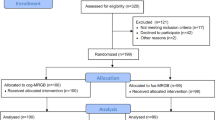Abstract
Background:
Analysis of systematic 12-core biopsies (SBx) has shown that African-American (AA) men tend to harbor higher risk prostate cancer (PCa) at presentation relative to other races. Multiparametric magnetic resonance imaging (mpMRI) and MRI-ultrasound fusion-guided biopsy (FBx) have been shown to diagnose more intermediate- and high-risk PCa in the general population; however, the efficacy in AA remains largely uncharacterized. We aim to evaluate the utility of FBx in an AA patient cohort.
Methods:
Men suspected of PCa underwent an mpMRI and FBx with concurrent SBx from 2007 to 2015 in this institutional review board-approved prospective cohort study. Patient demographics, imaging and fusion biopsy variables were collected. χ2, Mann–Whitney U-test and McNemar’s tests were performed to compare proportions, means and paired variables, respectively. Clinically significant PCa (CSPCa) was defined as Gleason score ⩾3+4.
Results:
Fusion biopsy demonstrated exact agreement with SBx risk categories in 64% of AA men. There was no statistically significant difference in the detection of CSPCa between FBx vs SBx (68 vs 62 cases, P=0.36). However, FBx detected 41% fewer cases of clinically insignificant PCa (CIPCa) compared with SBx (FBx 30 vs SBx 51 cases, P=0.0004). The combined FBx/SBx biopsy approach detected significantly more cases of CSPCa (FBx/SBx 80 vs SBx 62 cases, P=0.004) while detecting comparable number of cases of CIPCa (FBx/SBx 45 vs SBx 51 cases, P=0.37) compared with SBx alone. FBx/SBx also detected more CSPCa in patients with a history of prior negative SBx (FBx/SBx 28 vs 19 cases, P=0.003).
Conclusions:
FBx when used in combination with SBx detected more cases of CSPCa while not significantly increasing the diagnosis of CIPCa in AA men. Future multicenter studies will be needed to validate ultimately the clinical implications of FBx in AA patients.
This is a preview of subscription content, access via your institution
Access options
Subscribe to this journal
Receive 4 print issues and online access
$259.00 per year
only $64.75 per issue
Buy this article
- Purchase on Springer Link
- Instant access to full article PDF
Prices may be subject to local taxes which are calculated during checkout
Similar content being viewed by others
References
Torre LA, Siegel RL, Ward EM, Jemal A . Global cancer incidence and mortality rates and trends—an update. Cancer Epidemiol Biomarkers Prev 2015; 25: 16–27.
Center MM, Jemal A, Lortet-Tieulent J, Ward E, Ferlay J, Brawley O et al. International variation in prostate cancer incidence and mortality rates. Eur Urol 2012; 61: 1079–1092.
Gronberg H . Prostate cancer epidemiology. Lancet (London, England) 2003; 361: 859–864.
DeSantis CE, Siegel RL, Sauer AG, Miller KD, Fedewa SA, Alcaraz KI et al. Cancer statistics for African Americans, 2016: progress and opportunities in reducing racial disparities. Cancer J Clin 2016; 66: 290–308.
Jemal A, Center MM, DeSantis C, Ward EM . Global patterns of cancer incidence and mortality rates and trends. Cancer Epidemiol Biomarkers Prev 2010; 19: 1893–1907.
Miller DC, Litwin MS, Bergman J, Stepanian S, Connor SE, Kwan L et al. Prostate cancer severity among low income, uninsured men. J Urol 2009; 181: 579–583;discussion 83–84.
Siddiqui MM, Rais-Bahrami S, Turkbey B, George AK, Rothwax J, Shakir N et al. Comparison of MR/ultrasound fusion-guided biopsy with ultrasound-guided biopsy for the diagnosis of prostate cancer. JAMA 2015; 313: 390–397.
Scialpi M, Piscioli I, Malaspina S, D'Andrea A . Multiparametric magnetic resonance imaging-ultrasound fusion-guided prostate biopsy: role in diagnosis and management of prostatic cancer. Urol Oncol 2014; 32: 509–510.
Sonn GA, Margolis DJ, Marks LS . Target detection: magnetic resonance imaging-ultrasound fusion-guided prostate biopsy. Urol Oncol 2014; 32: 903–911.
Turkbey B, Pinto PA, Mani H, Bernardo M, Pang Y, McKinney YL et al. Prostate cancer: value of multiparametric MR imaging at 3T for detection—histopathologic correlation. Radiology 2010; 255: 89–99.
Yerram NK, Volkin D, Turkbey B, Nix J, Hoang AN, Vourganti S et al. Low suspicion lesions on multiparametric magnetic resonance imaging predict for the absence of high-risk prostate cancer. BJU Int 2012; 110: E783–E788.
Radiology ACo. Prostate Imaging Reporting and Data System (PIRADS). Available at: http://www.acr.org/Quality-Safety/Resources/PIRADS. Last accessed April 2016.
Powell IJ, Bock CH, Ruterbusch JJ, Sakr W . Evidence supports a faster growth rate and/or earlier transformation to clinically significant prostate cancer in black than in white American men, and influences racial progression and mortality disparity. J Urol 2010; 183: 1792–1796.
Jones BA, Liu WL, Araujo AB, Kasl SV, Silvera SN, Soler-Vila H et al. Explaining the race difference in prostate cancer stage at diagnosis. Cancer Epidemiol Biomarkers Prev 2008; 17: 2825–2834.
Albain KS, Unger JM, Crowley JJ, Coltman CA Jr, Hershman DL . Racial disparities in cancer survival among randomized clinical trials patients of the Southwest Oncology Group. J Natl Cancer Inst 2009; 101: 984–992.
Shin T, Smyth TB, Ukimura O, Ahmadi N, de Castro Abreu AL, Oishi M et al. Detection of prostate cancer using magnetic resonance imaging/ultrasonography image-fusion targeted biopsy in African-American men. BJU Int 2017.
Muthigi A, George AK, Sidana A, Kongnyuy M, Simon R, Moreno V et al. Missing the mark: prostate cancer upgrading by systematic biopsy over magnetic resonance imaging/transrectal ultrasound fusion biopsy. J Urol 2017; 197: 327–334.
Kongnyuy M, Sidana A, George AK, Muthigi A, Iyer A, Fascelli M et al. The significance of anterior prostate lesions on multiparametric magnetic resonance imaging in African-American men. Urol Oncol 2016; 34: 254.e15–254.e21.
Kongnyuy M, George AK, Rastinehad AR, Pinto PA . Magnetic resonance imaging-ultrasound fusion-guided prostate biopsy: review of technology, techniques, and outcomes. Curr Urol Rep 2016; 17: 32.
Rosenkrantz AB, Verma S, Choyke P, Eberhardt SC, Eggener SE, Gaitonde K et al. Prostate magnetic resonance imaging and magnetic resonance imaging targeted biopsy in patients with a prior negative biopsy: A Consensus Statement by AUA and SAR. J Urol 2016; 196: 1613–1618.
Rastinehad AR, Abboud SF, George AK, Frye T, Ho R, Chelluri R et al. Reproducibility of multiparametric MRI and fusion-guided prostate biopsy: multi-institutional external validation by a propensity score matched cohort. J Urol 2016; 195: 1737–1743.
Ploussard G, Epstein JI, Montironi R, Carroll PR, Wirth M, Grimm MO et al. The contemporary concept of significant versus insignificant prostate cancer. Eur Urol 2011; 60: 291–303.
Esserman LJ, Thompson IM, Reid B, Nelson P, Ransohoff DF, Welch HG et al. Addressing overdiagnosis and overtreatment in cancer: a prescription for change. Lancet Oncol 2014; 15: e234–e242.
Sundi D, Faisal FA, Trock BJ, Landis PK, Feng Z, Ross AE et al. Reclassification rates are higher among African American men than Caucasians on active surveillance. Urology 2015; 85: 155–160.
Fernandes ET, Sundaram CP, Long R, Soltani M, Ercole CJ . Biopsy Gleason score: how does it correlate with the final pathological diagnosis in prostate cancer? Br J Urol 1997; 79: 615–617.
Chun FK, Steuber T, Erbersdobler A, Currlin E, Walz J, Schlomm T et al. Development and internal validation of a nomogram predicting the probability of prostate cancer Gleason sum upgrading between biopsy and radical prostatectomy pathology. Eur Urol 2006; 49: 820–826.
Valerio M, Donaldson I, Emberton M, Ehdaie B, Hadaschik BA, Marks LS et al. Detection of clinically significant prostate cancer using magnetic resonance imaging-ultrasound fusion targeted biopsy: a systematic review. Eur Urol 2015; 68: 8–19.
Moore CM, Robertson NL, Arsanious N, Middleton T, Villers A, Klotz L et al. Image-guided prostate biopsy using magnetic resonance imaging-derived targets: a systematic review. Eur Urol 2013; 63: 125–140.
Muthigi A, Sidana A, George AK, Kongnyuy M, Maruf M, Valayil S et al. Current beliefs and practice patterns among urologists regarding prostate magnetic resonance imaging and magnetic resonance-targeted biopsy. Urol Oncol 2017; 35: 32.e1–32.e7.
Acknowledgements
We would like to acknowledge our data managers who prospectively maintain our databases.
Author information
Authors and Affiliations
Corresponding author
Ethics declarations
Competing interests
The authors declare no conflict of interest.
Rights and permissions
About this article
Cite this article
Kongnyuy, M., Siddiqui, M., George, A. et al. Multiparametric MRI/ultrasound fusion-guided biopsy decreases detection of indolent cancer in African-American men. Prostate Cancer Prostatic Dis 20, 348–351 (2017). https://doi.org/10.1038/pcan.2017.21
Received:
Revised:
Accepted:
Published:
Issue Date:
DOI: https://doi.org/10.1038/pcan.2017.21
This article is cited by
-
Fokale Therapie bei Prostatakrebs
Der Urologe (2019)



